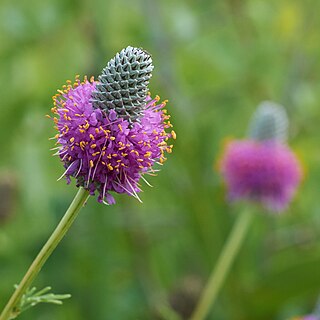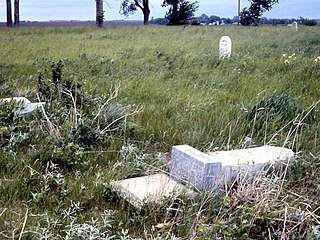
Forage is a plant material eaten by grazing livestock. Historically, the term forage has meant only plants eaten by the animals directly as pasture, crop residue, or immature cereal crops, but it is also used more loosely to include similar plants cut for fodder and carried to the animals, especially as hay or silage.

Pawnee National Grassland is a United States National Grassland located in northeastern Colorado on the Colorado Eastern Plains. The grassland is located in the South Platte River basin in remote northern and extreme northeastern Weld County between Greeley and Sterling. It comprises two parcels totaling 193,060 acres (78,130 ha) largely between State Highway 14 and the Wyoming border. The larger eastern parcel lies adjacent to the borders of both Nebraska and Wyoming. It is administered in conjunction with the Arapaho-Roosevelt National Forest from the U.S. Forest Service office in Fort Collins, with a local ranger district office in Greeley.
On Nature's Trail was a television show produced by the Maryland Center for Public Broadcasting in 1978. The show featured Elmer and Jean Worthley observing and discussing plants growing at different locations in Baltimore County, Maryland. Observations were made at the same locations during the Spring, Summer and Fall.
The Elmhurst Great Western Prairie (EGWP) is a six-acre, one mile long prairie remnant located immediately north of the Illinois Prairie Path in Elmhurst, Illinois. The EGWP has been maintained largely by volunteers since 1977 and is owned by the Elmhurst Park District.
The North America Prairies is a large grassland floristic province within the North American Atlantic Region, a floristic region within the Holarctic Kingdom. It lies between the Appalachian Province and the Rocky Mountains and includes the prairies of the Great Plains. It is bounded by the Canadian coniferous forests on the north and the arid semideserts to the southwest. The province itself is occupied by temperate grasslands, savannas, and shrublands. Endemism is rather limited in this province, and its boundaries are vague. During the Pleistocene much of the province was glaciated.

Carex specuicola is a rare species of sedge known by the common name Navajo sedge. It is native to a small section of the Colorado Plateau in the United States, its distribution straddling the border between Utah and Arizona, and completely within the Navajo Nation. There are several populations but they are limited to a specific type of habitat. The plants grow from the sides of steep, often vertical cliffs of red Navajo Sandstone, in areas where water trickles from the rock. It occurs at elevations between 5,700 and 6,000 feet, usually in shady spots. Though it is not a grass, the sedge grows in inconspicuous clumps resembling tufts of grass sticking out of the rock face. When the sedge was federally listed as a threatened species in 1985, it was known from only three populations in Coconino County, Arizona, with no more than 700 plants existing. The species has since been observed in northeastern Arizona and San Juan County, Utah.

Dalea purpurea is a species of flowering plant in the legume family known as purple prairie clover. Native to central North America, purple prairie clover is a relatively common member of the Great Plains and prairie ecosystems. It blooms in the summer with dense spikes of bright purple flowers that attract many species of insects.

Carex inops is a species of sedge known as long-stolon sedge and western oak sedge. It is native to northern North America, where it occurs throughout the southern half of Canada and the western and central United States.

Kankakee Sands is a 10,000-acre (4,000 ha) restored tallgrass prairie in Kankakee County, Illinois and Newton County, Indiana. It is managed by The Nature Conservancy staff and volunteers. The Efroymson Restoration at Kankakee Sands is 8,400 acres (3,400 ha) of prairies and wetlands connecting Willow Slough Fish and Wildlife Area, Beaver Lake Nature Preserve, Conrad Savanna Nature Preserve and Conrad Station Savanna. This creates over 20,000 acres (8,100 ha) of dry, mesic and wet sand prairies, sand blows, sedge meadows, wetlands, and black oak savannas.
Stephens State Forest is the a state forest located in Lucas, Clarke, Monroe, Appanoose and Davis Counties in Iowa. Stephens State Forest is 15,500 acres and split into 7 separate locations that collectively make up the largest state forest in Iowa.

Cemetery prairies are remnants of native North American prairie that survive on land set aside by settlers as burial grounds. These places were thus left unplowed and largely undisturbed, such that the cemeteries became de facto nature preserves. Natural prairie grasses are often perennial species that regrow from the roots after ruminant grazing or grassfire; plowing destroys the root system and eventually the ecosystem.









